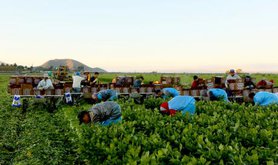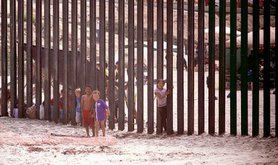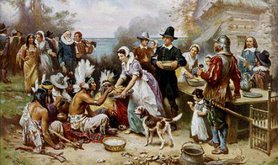
US Border Patrol on the US-Mexico border. byroN José sun/Flickr. Creative Commons.
We are led to believe that there is something self-evident and straightforward about migrant ‘illegality’. Some migrants are categorised as ‘illegal’ because they have presumably violated ‘the Law’. Yet in most depictions of these migrants, there is little if any account of what the law truly is, or of how it came to be so. The law, after all, has a history, and it is a deeply politicised history of deliberate and more or less calculated interventions. As such, it is impossible to contemplate the real social and political condition of migrants outside of the larger contexts that produce specific predicaments of ‘illegality’.
Migrants only become ‘illegal’ when legislative or enforcement-based measures render particular migrations or types of migration ‘illegal’—or in other words, illegalise them. From this standpoint, there are not really ‘illegal’ migrants so much as illegalised migrants. The real origins of such illegalisations are to be found in the deliberations, debates, and decisions of lawmakers. The law that illegalises migrants remains largely invisible, while the spectre of the devious and cunning migrant becomes hyper-visible through mass media representations of border policing. This is what I have described in my book Working the Boundaries as a spectacle of enforcement at ‘the’ border, whereby migrant ‘illegality’ is rendered spectacularly visible.
The Border Spectacle sets a scene that appears to be all about ‘exclusion,’ where allegedly ‘unwanted’ or ‘undesirable’—and in any case, ‘unqualified’ or ‘ineligible’— migrants must be stopped, kept out, and turned around. At the same time, the border appears to demonstrate, verify, and legitimate the purported naturalness and putative necessity of such exclusion. The concrete practices of border policing interweave with this sort of language and imagery to turn migrant ‘illegality’ into a seemingly ‘real’ thing.
This scene of exclusion is nevertheless always accompanied by its shadowy, publicly unacknowledged or disavowed, obscene supplement: the large-scale recruitment of illegalised migrants as legally vulnerable, precarious, and thus tractable labour. In the face of increasingly fortified, militarised and securitised borders, those who elude detection and evade apprehension are rewarded with the protracted and indefinite social condition called ‘illegality’ and all its attendant deprivations.
Above all, migrant ‘illegality’ is accompanied by deportability: the possibility of being forcibly removed from the space of the state. It is this grim prospect of coercive expulsion that characterises their labour-power. Extraordinarily vulnerable workers living in permanent fear of the Law are, after all, very lucrative for employers. The exclusionary brashness of the Border Spectacle, then, is inseparable from its obscene underbelly: the real social relation of illegalised migrants to the state, and the public secret of their abject inclusion as ‘illegal’ labour.
Obscene inclusion
The Border Spectacle, as we have seen, conjures up the image of migrants’ transgression of borders. It works its magic trick of displacing ‘illegality’ from its point of production—the processes of lawmaking—to the so-called ‘scene of the crime.’ This, of course, doubles as the scene of ostensible crime-fighting, a key part of making the border a preeminent scene of exclusion. Human mobility nevertheless prevails. This happens despite the accumulated pressure and violence inflicted at borders, zones which are increasingly intruding into the ‘interior’ of the nation-state’s space and the everyday lives of both migrants and citizens. These dynamics that illegalise migrants and produce the conditions for the exploitation of their labour are what I call their obscene inclusion.
Obscenity is less about concealment than selective exposure. Even as the state’s lawmaking produces migrant ‘illegality’ as an enduring ‘problem,’ spectacles of border policing nonetheless reaffirm the existence of a subordinate reserve army of deportable labour ready and available within the space of the nation-state. In this way, the Border Spectacle appears to show the state’s diligent but ever-beleaguered ‘response’ to the phantom ‘crisis’ of border ‘invasion’ by desperate hordes of ‘illegal’ migrants and asylum-seekers. The nightmarish invasiveness, relentlessness, and ubiquity of ‘illegal’ migration then serves to summon forth ever more intense and expansive intrusions of state power into everyday life for everyone.
The related discourses of ‘human trafficking’ and ‘migrant smuggling’ further allow the state to fashion itself as a paternalistic (indeed, patriarchal) “protection racket,” to use Charles Tilly’s term. In these instances, the state’s ‘protection’ is benevolently extended beyond its ‘rightful’ citizens to include some migrants, particularly women purportedly rescued from the intrinsic criminal excesses of ‘illegal’ migration itself. The ‘trafficking’ discourse thus narrowly identifies the source of the migrants’ ‘exploitation’ as a ‘foreign’ one — ‘smugglers’, and the whole ‘opportunistic’ infrastructure of ‘illegal’ migration itself. In this way, illegalised migrants are deemed to be in need of ‘protection’—from one another!
Almost never do such discourses interrogate the larger border and immigration regimes creating the need for precarious and vulnerable forms of ‘illegal’ border crossing, and consequently broadening the space to exploit migrants and asylum-seekers. At the same time, the exposure of pitiful and helpless ‘victims’ of ‘migrant smuggling’ nonetheless verifies the existence of a shadowy population of docile and infinitely tractable migrant denizens. In this respect, we see again how the Border Spectacle—as a scene of exclusion—affirms the obscene fact of a kind of subordinate inclusion. The sanctimonious but fundamentally hypocritical discourses decrying ‘migrant smuggling’ and ‘human trafficking’ serve as premier examples of the Border Spectacle’s acts of obscenity, exposing its own ‘dirty secret’.
Essentialised exploitability
The representation of migrants as either ‘victims’ or opportunistic ‘criminals’ effectively erases the kind of agency that might count as self-determination. The disqualification of these illegalised migrants from the capacity for self-determination furthermore implies that they are incompetent for self-government and democratic citizenship. This framing effectively reduces the exploitation of ‘illegal’ migrations to little more than a verification of their exploitability: their subjugation merely seems to prove their essential slavishness. This transposes the politics of citizenship and the inequalities of immigration into an essentialist politics of ‘difference’ that appears to arise from the migrants’ ‘foreignness.’
The unequal politics of citizenship, which is institutionalised in immigration law, produces migrant ‘illegality’. The Border Spectacle systematically re-renders that same ‘illegality’ into a quasi-inherent deficiency of the migrants themselves. This displacement of juridical inequalities and border injustices onto the illegalised migrants themselves—including patronising discourses that present migrants as purely passive ‘victims’—inevitably contributes to the migrants’ racialisation.
Read more
Get our weekly email



Comments
We encourage anyone to comment, please consult the oD commenting guidelines if you have any questions.